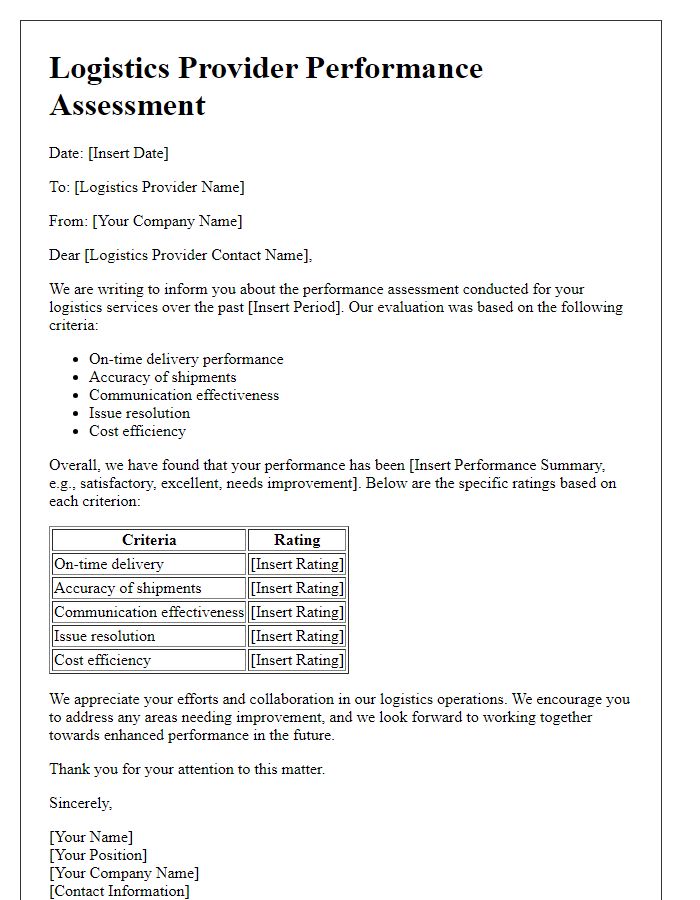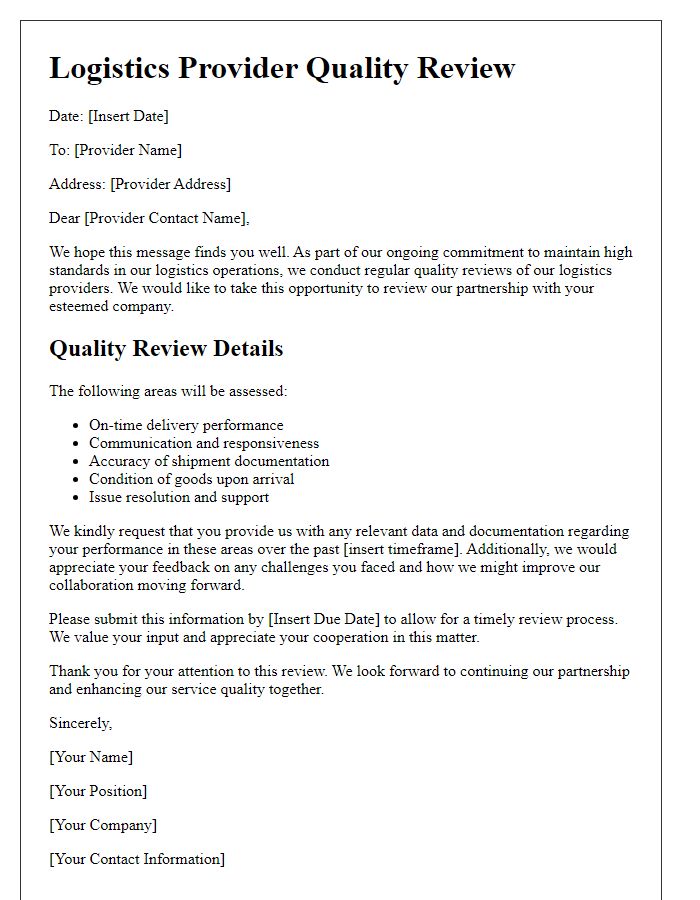Are you looking to streamline your logistics operations and improve efficiency? Evaluating your logistics provider is a crucial step in ensuring that your supply chain runs smoothly and meets your business needs. In this article, we'll discuss key factors to consider during the evaluation process, along with some practical tips to help you make an informed decision. So, buckle up and join us as we explore the essentials for choosing the right logistics partner!

Objective of Evaluation
The objective of logistics provider evaluation focuses on assessing the performance and capabilities of third-party logistics (3PL) companies. This evaluation aims to determine the effectiveness of supply chain management, including transportation efficiency, warehousing accuracy, and inventory management. Key performance indicators (KPIs) such as on-time delivery rates (target 98% or higher), order accuracy rates (aiming for 99.5% accuracy), and customer satisfaction scores (measured via surveys) are critical metrics in this assessment. Evaluations also consider the provider's technology integration capabilities, including real-time tracking systems, fleet management software, and warehouse management systems (WMS). Ultimately, the assessment seeks to identify the most reliable logistics partner to enhance distribution processes, reduce operational costs, and improve overall service levels.
Evaluation Criteria
A logistics provider evaluation focuses on critical factors such as cost efficiency, service reliability, and operational performance. Cost efficiency involves analyzing pricing structures, including transportation fees, handling charges, and additional costs associated with logistics. Service reliability examines the provider's history of meeting delivery timelines, order accuracy rates, and the consistency of service quality. Operational performance assesses the provider's inventory management capabilities, technology utilization, and ability to handle peak demand periods or unforeseen disruptions, such as natural disasters or supply chain delays. Compliance with regulatory standards, sustainability practices, and customer support quality also play essential roles in the evaluation process, ensuring the logistics provider aligns with the organization's overall goals and values.
Performance Metrics
The evaluation of a logistics provider involves analyzing various performance metrics critical to supply chain efficiency. Key performance indicators (KPIs) such as on-time delivery rates, order accuracy, and shipment tracking effectiveness play essential roles. For instance, on-time delivery should ideally exceed 95% to maintain customer satisfaction. Order accuracy must reach at least 99% to reduce returns and ensure inventory integrity. Additionally, the responsiveness of customer support services can be measured through average resolution time, which should remain below 24 hours for effective communication. Other important metrics include freight cost per unit and inventory turnover rate, directly impacting overall costs and operational efficiency. This comprehensive assessment ensures that logistics partners meet business demands and align with organizational goals.
Strengths and Weaknesses Analysis
A comprehensive evaluation of logistics providers reveals key strengths and weaknesses crucial for decision-making in supply chain optimization. For instance, efficient providers exhibit strong infrastructure, including advanced warehouse management systems and state-of-the-art transportation fleets, facilitating timely deliveries (often exceeding 95% on-time performance). Additionally, strong customer service ratings, frequently above 4.5 stars, indicate effective communication channels and responsiveness to client needs. However, potential weaknesses may include limited geographical coverage, which could hinder service in remote regions, and inconsistent pricing structures that may create budgeting challenges. Furthermore, some providers may lack integration capabilities with existing enterprise resource planning (ERP) systems, affecting workflow efficiency. Analyzing these factors can guide businesses in selecting a logistics partner aligned with their operational goals.
Recommendations and Conclusion
Evaluating logistics providers involves analyzing various factors that influence operational efficiency and customer satisfaction. Criteria such as on-time delivery rates (often above 95% for leading providers), cost efficiency measured through transportation costs per mile, and the technology infrastructure utilized (like advanced tracking systems) are vital. Recommendations should include engaging providers with robust networks, particularly those with established intermodal capabilities for diverse shipping needs. Conclusion should emphasize the importance of continuous performance monitoring, suggesting quarterly reviews to align practices with evolving business demands, thus ensuring optimal supply chain management.
Letter Template For Logistics Provider Evaluation Samples
Letter template of logistics provider operational effectiveness evaluation













Comments